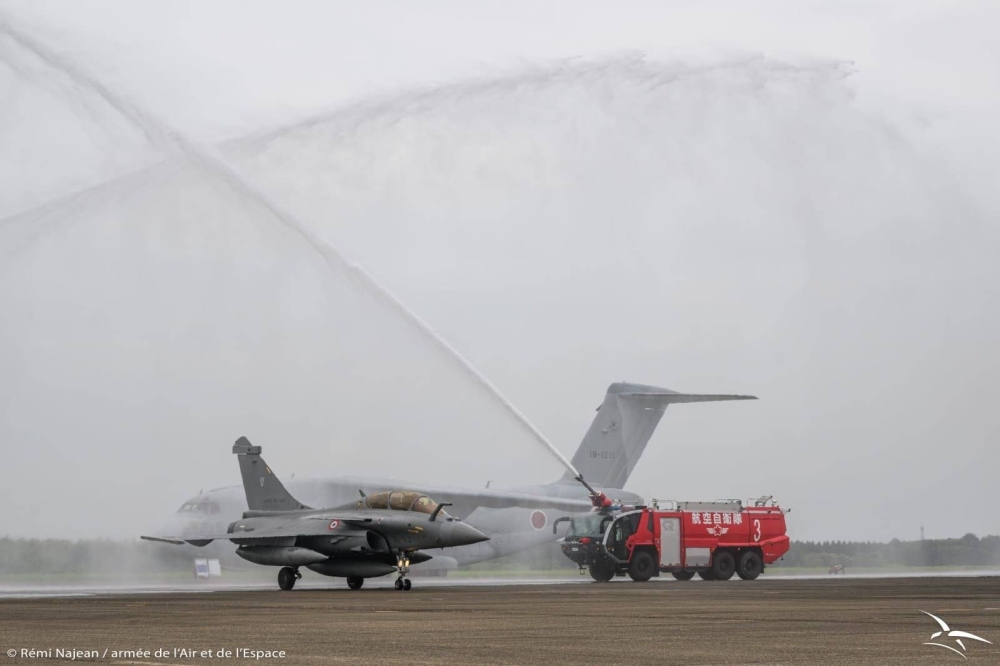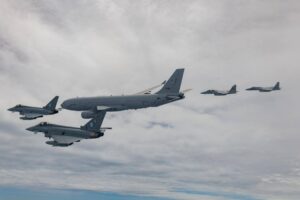Tras la noticia se encuentra la traducción al español, realizada por el Coronel Muñoz Sanchez
A contingent of more than 30 military aircraft from Germany, France and Spain arrived in Japan on Friday to conduct a series of training exercises with the Air Self-Defense Force, marking these countries’ first-ever trilateral air force deployment to the Indo-Pacific.
The aircraft’s arrival from Alaska follows their participation in the Arctic Defender aerial combat drills, the first leg of a two-month, trinational Pacific Skies deployment that will also see the German, French and Spanish air forces exercise with regional partners such as Japan, India and Australia.
Aimed at improving tactical skills and promoting mutual understanding, the two-day aerial maneuvers beginning Friday highlight the expanding defense ties between Tokyo and key European partners – particularly NATO members – as they align their strategic interests amid shared economic and security concerns.
The ASDF’s drills with France will take in the airspace around Hyakuri Air Base in Ibaraki Prefecture, while those with both Germany and Spain will be held in the airspace around Chitose Air Base in Hokkaido, according to the Defense Ministry.
Both Germany and Spain have sent Eurofighter Typhoons, while France is fielding Rafale jets. They are accompanied by several transport and aerial refueling aircraft as well as several hundred personnel. The ASDF is set to deploy F-2 fighters for its maneuvers with France and F-15s for separate drills with Spain and Germany.
But that’s not all.
From July 22 to 25, the ASDF and the Luftwaffe will hold their first-ever bilateral exercise known as Nippon Skies, in a follow-up to the German air force’s first-ever visit to Japan in 2022.
A Luftwaffe spokesperson told The Japan Times that three of the eight Eurofighter Typhoons will stay at Chitose Air Base to take part in the joint drills, while the rest will fly on to Australia alongside the French and Spanish aircraft for the Pitch Black multilateral exercise.
The Pitch Black drills will also include an ASDF contingent.
These activities will in turn be followed by a separate ASDF exercise with the Italian Air Force called Rising Sun, which is to be held from Aug. 6 to 8 in the airspace around Misawa Air Base, Aomori Prefecture.
These tactical drills will see Italy send transport and early warning aircraft as well as four F-35As and an equal number of Eurofighters, while Japan will field four F-35As and an aerial tanker.

“The successive visits to the Indo-Pacific region by the armed forces of these countries are proof of their willingness and ability to engage in the Indo-Pacific region,” Defense Minister Minoru Kihara said last month.
This will “not only improve the Self-Defense Forces’ tactical skills, but also deepen cooperation with other countries and help realize a free and open Indo-Pacific region,” he added.
The rapid succession of bilateral and multilateral military engagements follows ASDF exercises with a growing number of countries last year and comes as Tokyo seeks to enhance ties and deepen interoperability with an expanding network of security partners.
Both Europe and Japan are concerned about what they view as mounting challenges to the international order, including the war in Ukraine, supply chain disruptions and security tensions in East Asia.
This has resulted in a number of European countries intensifying defense, diplomatic and economic security cooperation with not only Japan but also other U.S. regional allies such as South Korea, Australia and the Philippines.
Like Japan, these nations have embraced the argument that the security of Europe is “inseparable” from that of the Indo-Pacific, a claim that has become the rationale behind NATO’s increasingly close ties with its regional partners.
CAZAS ALEMANES, FRANCESES Y ESPAÑOLES LLEGAN A JAPÓN PARA MANIOBRAS CONJUNTAS

Two Air Self-Defense Force F-15s (right) escort two German Air Force Eurofighter jets and an A330MRTT aerial tanker on their arrival in Japan Friday. The ASDF is conducting training exercises with the German, French and Spanish air forces this weekend. | COURTESY OF BUNDESWEHR / CHRISTIAN TIMMIG
(Pie de foto): Dos cazas F15 de la ASDF (Fuerza Aérea para la Defensa Propia) de EEUU (a la derecha) escoltan a dos cazas Eurofighters alemanes y un avión cisterna A330MRTT a su llegada a Japón el viernes. La ASDF está realizando maniobras con las fuerzas aéreas de Alemania, Francia y España este fin de semana. (Ministerio de Defensa de Alemania/Christian Timmig)
20 de julio de 2024
Una flota de más de 30 aviones de las fuerzas aéreas de Alemania, Francia y España llegaron a Japón el viernes para realizar maniobras con la ASDF como el primer despliegue aéreo trilateral de estas naciones jamás realizado en la zona del Indo-Pacífico.
La llegada de los aviones desde Alaska sigue a su participación en las maniobras de combate aéreo Arctic Defender, primera fase de un ‘despliegue Skies Pacific’ de tres países que también será testigo de maniobras de las fuerzas aéreas de Alemania, Francia y España con socios de la región, región tales como Japón, India y Australia.
Destinadas a la mejora táctica y la promoción del entendimiento mutuo, las maniobras aéreas de dos días que comienzan el viernes ponen de manifiesto la ampliación de los lazos de defensa entre Tokio y socios europeos claves –en particular miembros de OTAN- en su voluntad de alinear sus intereses estratégicos con las preocupaciones económicas y de seguridad.
Las maniobras de ASDF con Francia se realizarán en el espacio aéreo de la base aérea de Hyakuri, en la prefectura de Ibaraki, en tanto que aquellas con Alemania y España lo serán en el espacio aéreo de la base aérea de Chitose, en Hokkaido, según el ministerio de Defensa.
Tano Alemania como España han enviado Eurofighters Typhoons, mientras Francia aporta reactores Rafale. Van acompañados de varios aviones de transporte y cisternas así como varios centenares de personal. ASDF se dispone a desplegar cazas F2 con Francia a F 15 para las maniobras con Alemania y España.
Pero esto no es todo.
De 22 a 25 de julio ASDF y la fuerza aérea alemana realizarán sus primeras maniobras bilaterales, conocidas como Nippon Skies, a continuación de la primera visita de la fuerza aérea alemana a Japón en 2022.
Un portavoz de la fuerza aérea alemana dijo a Japan Times que tres de los ocho cazas Typhoons estarán en la base aérea de Chitose para tomar parte en las maniobras conjuntas, mientras que el resto partirán hacia Australia con los de Francia y España para las maniobras multilaterales Pitch Black.
Las maniobras Pitch Black incluirán también un contingente de ASDF.
Estas operaciones se verán seguidas a su vez por unas maniobras separadas de ASDF con Italia, denominadas Rising Sun, a ser celebradas del 6 al 8 de agosto en el espacio aéreo de la base aérea de Misawa Air en la prefectura de Aomori.
En estas maniobras tácticas Italia participará con aviones de transporte y alerta temprana así como cuatro F15A y una cantidad igual de Eurofighters, mientras que Japón lo hará con cuatro F35A y un avión cisterna.
(Pie de foto): Un caza Rafale francés discurre por la base aérea de Hyakuri, en la prefectura de Ibaraki, después de aterrizar el viernes. (Ministerio del Aire y el Espacio de Francia/Remi Najean).
“Las sucesivas visitas a la región Indo-Pacific por las fuerzas armadas de estos países son prueba de su voluntad y capacidad de comprometerse en la región Indo-Pacific”, dijo el mes pasado el ministro de Defensa Minoru Kihara.
Esto, “no sólo mejorará las capacidades tácticas de nuestras SDF (Fuerzas de Defensa Propia) sino profundizará la cooperación con otros países y ayudará a conseguir una región Indo-Pacific libre y abierta”, añadió.
La rápida sucesión de maniobras militares bi y multilaterales sigue a las de ASDF con una creciente cantidad de países el año pasado y se produce cuando Tokio intenta mejorar los lazos y ampliar la interoperabilidad con una red en expansión de socios en seguridad.
Tanto Europa como Japón están preocupados por lo que consideran unas crecientes amenazas al orden internacional, incluyendo la guerra de Ucrania, los fallos en la cadena de suministros y las tensiones para la seguridad en Asia Oriental.
Todo ello ha resultado en una cantidad cada vez mayor de países europeos que intensifican la cooperación en defensa, diplomacia y seguridad económica, no sólo con Japón sino también con otros aliados regionales de EEUU, tales como Corea del Sur, Australia y Filipinas.
Al igual que Japón, estos países han aceptado el argumento de que la seguridad de Europa es ‘inseparable’ de la del Indo-Pacific, aseveración que se ha vuelto el razonamiento que se esconde detrás de los cada vez más fuertes lazo de OTAN con sus socios en la región.
Por la trascripción:
Leopoldo Muñoz Sánchez
Coronel de Intendencia ET (R)

